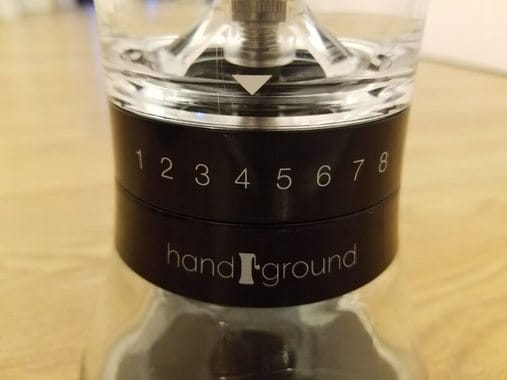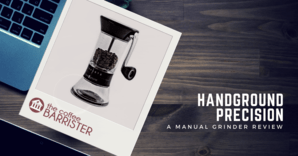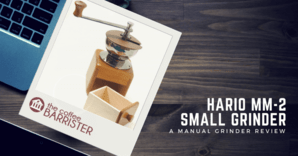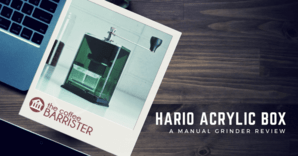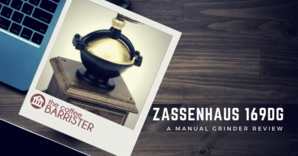Are you brewing coffee at home? If you are, then you should always grind your own coffee beans. It gives the cup of coffee more flavors.
Traditionally, manual hand grinders are cost-effective and convenient. Most “home baristas” prefer it, but still, gives even the most professional barista problems.
For traditional manual grinders, these include:
- Wobbling Base - hard to hold and grind simultaneously
- Size & Consistency - difficult to control and change
- Tiredness - horizontal handle no ergonomically designed
- No Lid - coffee beans will fly everywhere!
The Handground Precision Coffee Grinder fixes lots of these problems. As a crowdsourced design project on Kickstarter, this hand-held grinder is the brainchild of hundreds of coffee specialists around the world. With the collective effort from the industry, this machine provides coffee enthusiasts with unprecedented control and ease-of-use that’s not seen in many other popular manual grinder designs.
OVERALL RATING: 4/5 STARS
Pros
- 15-preset grind settings on the outside
- Heavy-duty and long lasting ceramic burrs
- Easy-to-clean
- Ergonomically designed (more on this below)
- Wider bottom that added stability and reduced wobbling
Cons
- Price more expensive than competitors
- Can't fine-tune grind settings (large steps)
- Unsuitable for travel - too big
The Handground Precision Grinder's Main Features
- Ergonomic Designed Handle: The handle is double the size and mounted on the side, which gives you an easier time grinding because you’ll the turning motion will be more natural.
- External Grind Controls: Control the grind settings on the outside. Say bye bye to the annoying and time consuming process of taking the grinder apart and changing the settings inside!
- 3-Mounted Axle: The grinder is stabilized with a stainless-steel axle that’s mounted on 3 positions. The triple axle design will help create more even grinds and as a result, better tasting coffee.
What's The Handground Precision Grinder?
The Handground Precision Grinder is a manual coffee grinder that solves problems that’s prevalent in many other hand-held coffee grinders.
What makes the Handground so unique is it’s a Kickstarter project. The hand grinder is designed and developed by industry experts and specialists around the world. Through listening to over 100 coffee enthusiasts, the creators took the best designed, sorted everything out with the manufacturers, and came up with the product we see today.
Compared to its competitors, the biggest difference with the Precision Grinder is the side-mounted vertical handle and external click-wheel grind controls. The vertical handle makes it easier to grind coffee because the turning motion is more natural than if it’s horizontal. This helps reduce strain on your hands and forearms while grinding.
The external click-wheel, inspired by those on cameras, removes all the guesswork when you test different settings for your coffee grounds. With 15 settings (8 main and 7 half settings), you have a reasonable amount of control. However, it’s still very few compared to electric burr grinders that typically come with over 50 pre-set settings.
Lastly, the Handground grinder is designed to achieve the same level of consistency you get from high-end electric burr grinders. The 40mm ceramic burrs connect to a stainless-steel bar that is stabilized in 3 different points. This helps with reducing wobble internally and makes your grind come out the same each time. There are bloggers who noted that the Handground Precision is as consistent as the Mahlkonig EK-43 (expensive grinder). I agree to some extent but while experimenting, I noticed the grind consistency isn’t as good on coarser settings – so French Press people beware!
Overall, due to the immense commitment in both design and development, the Handground Precision is nearly twice as expensive than its direct competitors from companies like Hario and Jackpresse.
Video Review
The CEO of Handground, Daniel Vitiello made a video guide on what’s included in the product, and how to use it:
The Coffee Grinder's Detailed Review
Overall Quality: 5/5
The Handground Precision Grinder is an extremely well-built grinder. Everything is designed with quality and the user in mind. Subtle nuances like the wooden handle, add a warm aesthetic to this otherwise industrial looking design. With the side-mounted handle, it allows you to hold the grinder on the top instead of the bottom, which reduces wobble and strain when grinding.
The click-wheel grind controls are also very tactile and responsive, you’ll have no trouble figuring out exactly where the grind is.
Grind Consistency: 4/5
With other grinders, there is no way to easily figure out the grind size. Products such as the Hario Skerton uses a nut and screw system to change your grind. The challenge with this type of grinder is that you can’t tell how fine or coarse your coffee is.
If you accidentally lose count of how many times you turned the nut, then you’re screwed (pun intended).
Fortunately, the Handground Precision uses an easier to use external click-wheel control system. The controls come with 15 pre-set settings, 1 for Espresso and 8 for French Press. While the 15 settings might not give you as much freedom as other electric grinders, it should be enough to tackle needs of every brewing method and brewing machines. The click-wheel can feel a little wobbly if you change it all the time, but if it ever breaks, I read that Handground’s customer support team will help you sort it out (not 100% confirmed).
A big problem with manual coffee grinders is the ground’s consistency. Typically, other grinders are not as consistent because they wobble a lot. Although not completely resolving the problem, the Handground Precision tackles this with a wider base with grip pads at the bottom for better grip.
The grinder also reduces the internal burr wobble by joining the burrs to a sturdy steel axle that’s mounted to 3 point locations. Due to this commitment to detail, the coffee grinder can withstand a lot of movement internally. This gives you a consistent particle size across the entire grind range, quality that can rival commercial grinders (as said before).
Despite all the amazing improvements, the Handground Precision still comes with some inconsistency on coarser settings. When grinding coffee for French Press, I noticed the grind was visibly (fairly) inconsistent. To my knowledge, there’s no way to fine-tune or tweak it to get the right measurements at the moment. Overall, I think this machine is designed to focus more on the finer grinds.
Ease of Use: 4/5
With the design and build-quality of the grinder, it certainly is a step up from its competitors. Companies like Hario make a bulbously shaped grinder, and Porlex makes a very narrow grinder. Both shapes make it difficult to grip and control when you grind.
The Precision’s wider baton shape and vertical handle deals with this problem. The up and down movement of the handle is a lot easier to do than the standard horizontal movement of other grinders.
After using is for a while, you’ll notice that the coarseness click-wheel will become a bit loose, and the glass portion could shatter/crack (or so I’ve read). However, they’re all easy to replace. So if something is not working properly, you can easily replace it and it should work like it did when you first purchased it.
Price: 3/5
The price of the Handground Coffee Grinder is a lot higher than other manual coffee grinders on the market. The majority of its competitors are half the price or less, which is a lot more affordable. However, with the superior usability and grind performance on finer settings, the price tag could be justified.
Can’t make up your mind? Check out this guide on manual coffee grinders to learn more!
How Does It Compare To Other Manual Coffee Grinders?
Hario Skerton Ceramic Coffee Mill
The most popular manual grinder on the planet right now!
With its steel burrs, large open at the top, and storage for up to 16 cups of coffee, this is the preferred choice for coffee enthusiasts and baristas.
JavaPresse Manual Coffee Grinder
A stainless-steel coffee grinder that’s slim and cylindrical shaped – it’s perfect for packing and traveling. The JavaPresse comes with 18 pre-set grind setting, but like the Hario Skerton, there is no way to visually tell which setting you’re on. Since the JavaPresse is designed to be portable, it’s for 1 – 2 cups of coffee only.
Overall, if you’re looking for a more affordable coffee grinder, the Hario Skerton and JavaPresse manual coffee grinders will be the way to go. However, compared to the Handground Precision, you’ll be sacrificing lots of functionality, comfort, and controls over your coffee grounds.
The lack of functionality includes not being able to change your grind coarseness visually. This creates lots of guesswork, and will waste lots of coffee and time when you fine-tune your grind. For comfort, the Skerton and JavaPresse’s handle is set horizontally. It’ll be more difficult to grip and will create more strain for your arms.
The Coffee Barrister's Verdict [CONCLUSION]
It’s time for the Coffee Barrister’s Verdict! In my opinion, the answer to this question boils down to comfort and control.
When you’re experimenting with different grind size, trying to find the perfect grind and flavors…does it annoy you?
When you’re grinding, do you get tired or lose your grip from time to time?
If it’s a YES, then the Handground Precision Coffee Grinder will be great for you. I know the price point is higher than it’s competitors, but it’s superior performance (on fine grinds – medium grinds) more than makes up for it. With its external controls and ergonomic design, this grinder will take most of the hard work off your morning ritual.
It’ll allow you to focus on what really matters, enjoy your coffee.
- HIGH-QUALITY HAND COFFEE GRINDER designed by thousands of coffee...
- ADJUSTABLE GRIND SELECTOR with 15 settings giving precision to the...
- HASSLE-FREE GRINDING With A 40mm conical ceramic burr mill and triple...



